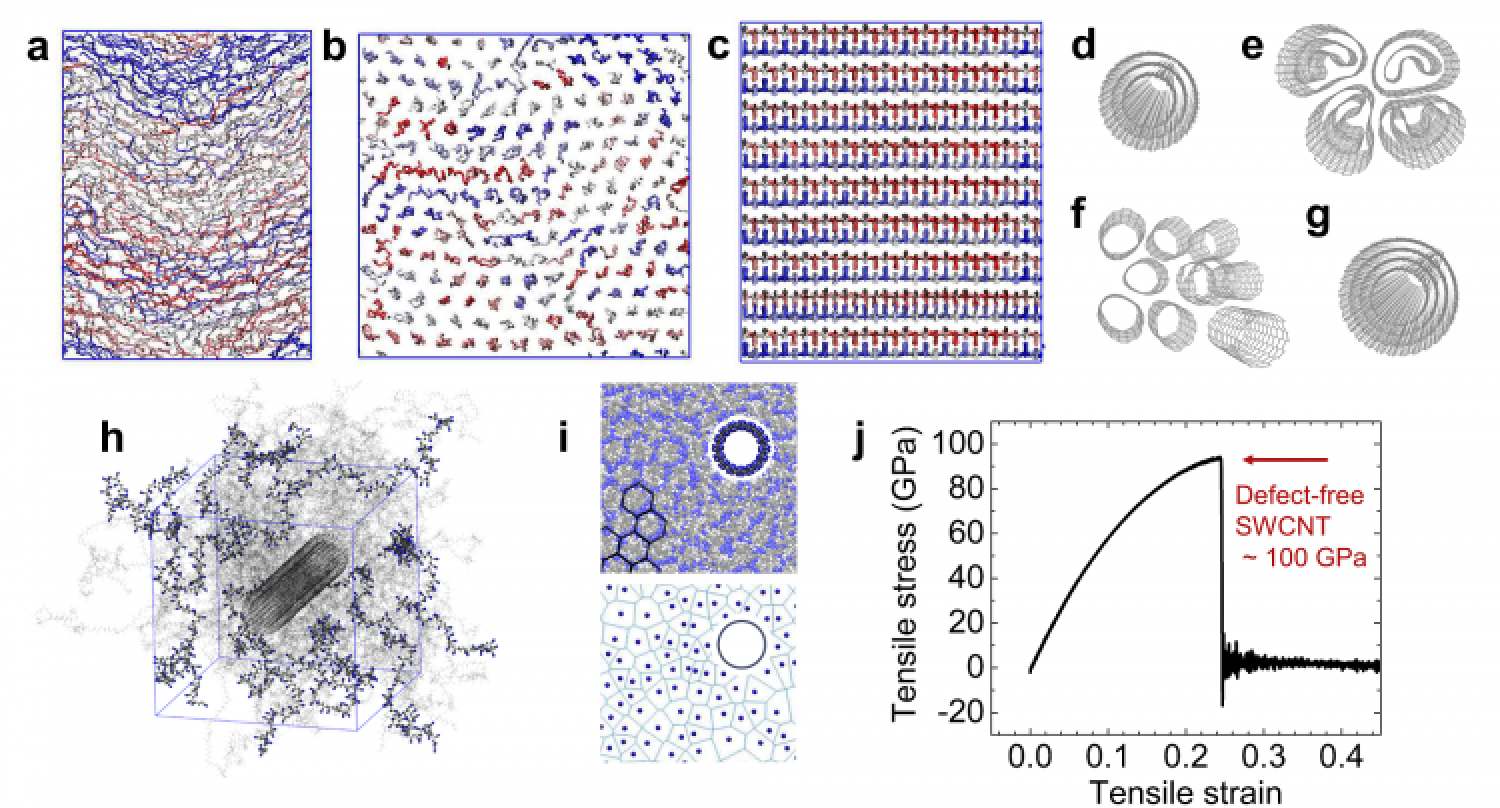Heinz starting new projects worth $3.8 million from National Science Foundation

Sample simulation models and stress-strain data for polymer/CNT composites at a scale of 10 nm. (a-c) Polyacrylonitrile with 50 pct to 100 pct crystallinity. (d-g) Various types of CNTs, flattened, roped, and defective graphitic structures. (h-i) Composite models and possible feature generation based on local ordering. (j) Sample stress-strain data from reactive simulations of CNTs.
The "Cyberloop for Accelerated Bionanomaterials Design" research project earned $1.8 million in NSF funding. With co-PIs Wonpil Im of Lehigh University and Ellad Tadmor of the University of Minnesota, Heinz is putting over 10 years of collaborative research into the building blocks of Cyberloop to work.
"We will develop a new cyberinfrastructure for computer simulation of biological and nanostructured materials," Heinz said. "We aim to simulate any compounds, mixtures, and reactions across the periodic table using computer programs and online web-based tools in at least 10 times higher accuracy than currently feasible.
"The grant will provide the first computational platform for simulations of interfaces accessible to non-experts and multiply usage of recent novel developments of intermolecular potentials in the interface force field and surface model databases developed by the Heinz lab via integration in CHARMM-GUI and OpenKIM and expansion, and user-friendly integration of these widely used programs."
This research grew out of the need for software compatibility and standardization among the research community, and will also serve to broaden the coverage and functionality in how nanomaterial simulations can be run.
Heinz is also the lead PI on another NSF grant-winning project: "Interpretable Augmented Intelligence for Multiscale Material Discovery," which earned $2 million in funds from the NSF. The co-PIs on this project are Yanxun Xu of Johns Hopkins University, Steve Sun of Columbia, Yusu Wang of Ohio State, and Wei Chen of the Illinois Institute of Technology.
This project was born out of the NSF's Ideas Lab Program, which aims to address interdisciplinary problems by bringing together top researchers for "sandpit" style, five-day workshops to build teams. Likened to "speed dating", the Ideas Lab helps form ad-hoc groups to address big questions in science and engineering.
This project aims to develop and depoy machine learning principles and artificial intelligence algorithms to expedite the design of composite materials and alloys that will be used in everything from cars to airplanes to space vehicles.
"The grant is expected to utilize large amouns of computational data on materials properties, as well as a growing amount of experimental imaging and tomography data for accurate prediction of mechanical properties using revolutionary cross-cutting algorithms and expertise in materials science, computer science, engineering, and statistics," Heinz said. "The applications can be very broad and permanent, with the potential to grow into a large center-based effort. The aim is the most effective utilization and mining of large amounts of data for accurate prediction of mechanical properties and optimization of materials structures. Our initial focus will be on ultra-strong carbon nanomaterials and alloys, where even a small improvement holds a very large market potential."
Examples of nanomaterials included in IFF and in the surface model database. Consistent representation of bonding, structure, and validation of energies enables compatibility.
"We would like to develop a faster, more predictive tool for mechanical property predictions of materials, focusing on polymer-carbon nanomaterials composites and alloys," Heinz said. "Specifically, we would like to quantify the role of defects, specific chemistry and composition for carbon-based nano materials and polymer composites to push back the current limits of ultimate tensile strength and modulus."
A deluge of scientific data sets can pose a problem for researchers. This technology aims to help bridge the knowledge gaps in a field flooded with information.
"The amount of publications, simulations, and imaging data is exponentially expanding and we need reliable data mining and learning algorithms tailored to scientific problems," Heinz said. "In this project, the interdisciplinary expertise of our team and collaborators holds the potential for breakthrough innovations in the accelerated prediction of materials properties."
Both grants were awarded in September. Heinz has also just been appointed to the editorial board of the Molecular Simulation journal.

